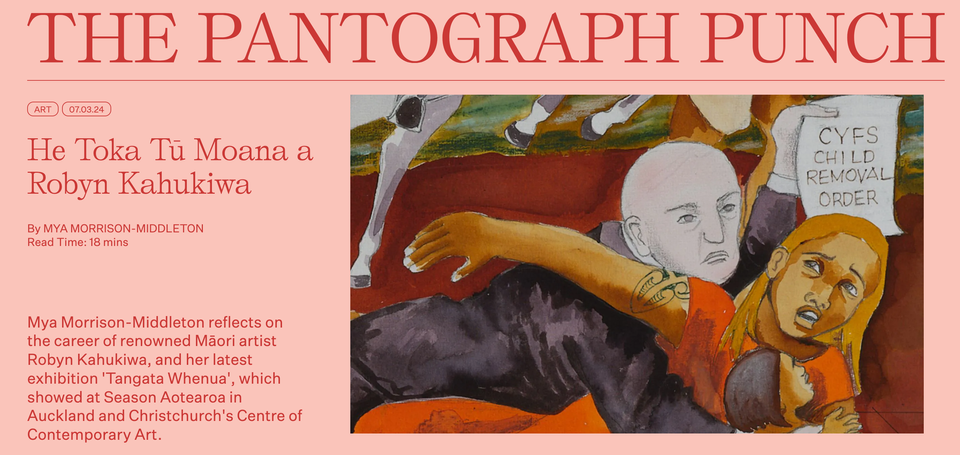Some Thoughts on the Pantograph Punch

After the Pantograph Punch announced it would be going on an indefinite hiatus, some thoughts from someone who once worked there, and who always read it.
This week, 14 years after it dropped on the internet with a hard-to-forget, tricky-to-get-right name, the Pantograph Punch announced it would be going on hiatus later this month. Anybody who has looked at media headlines since January shouldn’t be surprised by this, but it was still a shock. The site was a pillar of the arts media in this country, and while it won’t necessarily be “gone”, it won’t be holding anything new up for the forseeable future.
My time at the Pantograph Punch was only two years, where I moved from intern to theatre co-editor to staff writer, but felt like much more. I’ll remember my first interview forever – with Rosabel Tan, Hayden Donnell, Matt Hartnett – which took place at some place in Ponsonby that I’m certain has now closed or rebranded. One of the questions they asked me, specifically referencing a deeply critical review of a play I had seen, was if I would still write those kind of reviews. I eagerly said I would. (Nearly a decade later, I would adjust that answer: I would be that critical, but not quite that cruel.)
My time there ran the gamut. Some processes were an utter dream, with the digital ink flowing and the edits flowing just as easily. I’ve looked back at the work I made there and some of those reviews are the best I’ve ever written, thanks to the amount of time everybody was able to devote to it. These reviews started robust conversations between myself and artists, but more importantly, myself and audiences. I wouldn’t be the critic I am today without it. Others were, indisputably, difficult, whether it was due to a mismatch of personalities (mine absolutely included), a lack of time to devote to pieces, or just because sometimes the writing doesn’t come quick or easy. Often it doesn’t.

I left the Pantograph Punch a few months after I started at The Spinoff, which I’m sure was a bit too late to do so, but nobody was asking those questions at the time. At the time I left, the Pantograph Punch had shifted from being a buzzed-about arts publication to a fully-fledged arts organisation that ran events, had staff, and had several long-running projects. For a full year after I left, people asked if I was still working there.
That was the kind of status it held within the industry, on the scene. People were talking about it, people read it, and if your art was covered on the site, it meant your art was worth talking about. I can’t count the conversations I’ve had, or overheard, with people that only happened because the Pantograph Punch started them. Even as someone who was, after my time there, the subject of one of those conversations and not pleasantly so, I can still say that those conversations were so worth having, and our scene is richer for it.
It’s been fascinating to watch the Pantograph Punch shift as the landscape has shifted. The site went through a massive redesign (I’m still shocked to associate it with a colour beyond the monochrome), it embarked on more massive projects, and the staff went through a full turnover. What was once the cool kid on the block now became something like legacy media. Something that had always been around, surely.
If you looked even a bit closer, or had any knowledge of what it takes to run a media website with zero advertising content, it was easy to see how precarious it was. While the Pantograph Punch seemed as concrete as any other organisation, it was always looking for the next source of funding, often competing with other arts projects. (I have plenty of thoughts on media and artists seeking funding from the same pools, but for another time.)
14 years is a long time. But was it long enough? What function does an organisation and a platform like the Pantograph Punch serve in today’s media landscape? Over the past week, two of our largest media organisations have announced cuts and changes that don’t just affect the landscape, but the entire country. The grim hand of death looks to turn off life support for broadcast long-form journalism in this country. If you look broadly, one site going on hiatus indefinitely does not feel as seismic.
However, I can’t look at this announcement with a heavy dose of grief for the future. The conclusions reached by Rosabel Tan and Dr. James Wenley in their New Mirrors report are grim ones. Is funding arts media a priority when artists are going hungry, and an arts media centre means little with no arts media to actually use it. While I truly believe that anybody can be a critic, and an arts writer, specialised and high quality arts writing that has time spent on it is rare. This hiatus only makes it rarer.
Artists and audiences are islands, and arts media builds the bridges between them. Those bridges allow understanding, they allow communion, and ultimately, most importantly, they allow access. Without bridges, the world’s a whole lot quieter, a lot less explored, and ultimately, worse.
This post is available for free to Dramatic Pause subscribers. If you wish to become a paid subscriber, you can upgrade here.
Member discussion